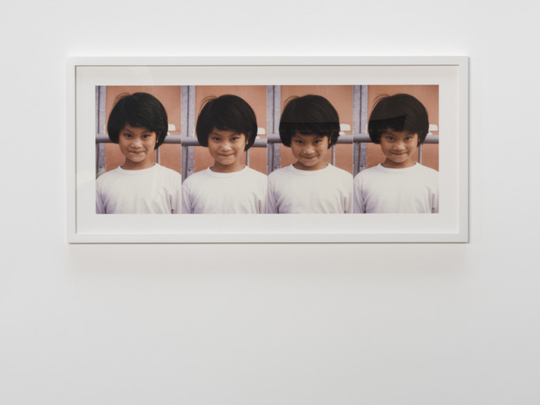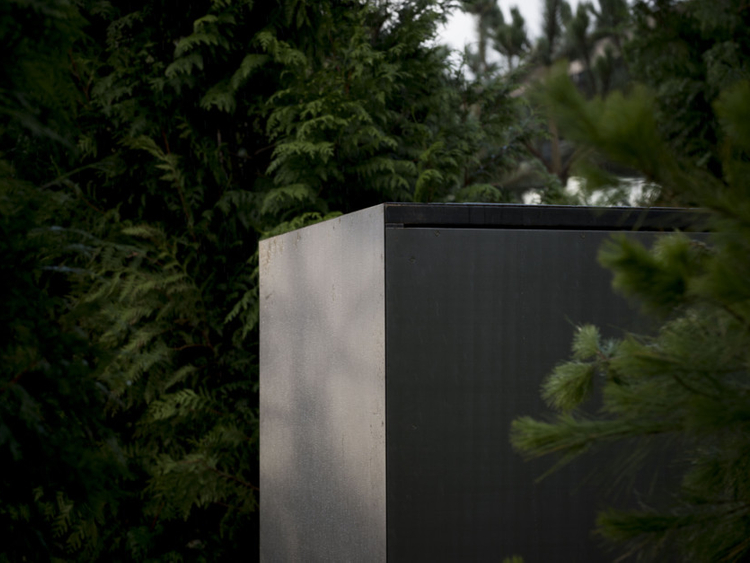
As a boy, Alfredo Jaar was so shy his father encouraged him to take up magic. “I used to perform in front of a mirror and then in front of my family. It gave me confidence,” the Chilean recalls. “I learnt about suspense and mystery. How to create a magic moment.”
Routinely described as an artist, architect and filmmaker, Jaar is more of a creative activist — constantly on the search for injustice, always highlighting oppression and foolhardiness.
His sense of theatre was hardened into angry agitprop during the dictatorship of Augusto Pinochet that scarred his home country from 1973 to 1990 and transformed into today’s political works, which expose oppression and injustice.
His latest target is the Central Intelligence Organisation, the very body that helped catapult Pinochet to power with the overthrow of Marxist president Salvador Allende.
In The Garden of Good and Evil at the Yorkshire Sculpture Park, he highlights the black sites, the secret detention centres operated by the CIA far out of sight in Thailand, Poland, Afghanistan, Romania, Guantanamo Bay and Diego Garcia.
“When the British handed Diego Garcia over to the Americans in 1973, they first drove out all the inhabitants and told the US that there was nothing here now except for seagulls. It has been used for renditioning their political victims ever since. No one knew, no one cares,” he reflects. “Things are happening far out of our reach.”
The work has all his hallmarks — thoughtful, challenging and precise. A grove of 101 evergreen trees in square tubs are lined in a tidy rectangle, their comforting greenery in contrast to nine steel cells, one-metre square, just big enough for a prisoner to kneel or crouch while they await torture.
“The cells are based on what I have read about torture chambers,” he says. “They contravene all humanitarian laws around the world. I was inspired by the poem One Square Metre of Prison by Palestinian poet Mahmoud Darwish, who was imprisoned many times after the Israeli occupation of his country in 1948.”
A political activist
It is a work that Jaar has been planning for some time but only now, with the offer to show it at the YSP, has he been able to make the project a reality. The cells will be placed and many of the trees planted in the park’s hilly, wooded, landscape once the exhibition closes.
The Garden of Good and Evil is a highly structured piece as befits a man who trained as an architect but who became a political activist, a provocateur, who exposes injustice and suffering with savage subtlety but also with a profound sense of humanity.
In the Pinochet years, he was part of a group of artists that resisted the regime.
“There were two schools of thought during the dictatorship,” he recalls. “One was that we should not exhibit our work, that we should be silent because anything we do in this climate means that we approve of the normality of the dictatorship, so some artists withdrew. Another school, with which I agreed, said ‘No, we have to occupy every single space available, we have to be present, we have to say we exist and show people that there is a different way of thinking.’ We created spaces of resistance and spaces of hope. We did it but in a very veiled way. We had to learn to do that in between the lines in very poetic ways, because if not, you were ‘disappeared’.”
He produced alternative exhibitions and painted graffiti and billboards reading, for example, Es Usted Feliz? (Are You Happy?).
After a while he found he was suffocating in Chile and realised he could no longer live there. He needed fresh air. He needed to get out.
He found the freedom to express his ideas when he moved to New York in 1982, where he made his name with an installation about the appalling conditions suffered by Brazilian miners. For a photographic series conceived in 1986 for the Spring Street subway station in New York, images of Serra Pelada miners were juxtaposed against current gold prices around the world. “This was the line that takes you from uptown Manhattan to Wall Street so brokers — dealing with gold in such an abstract way through their computers — suddenly saw what a gold mine was,” he says. “That was my way to bring my world to New York and it immediately put me on the world map.”
Ever since, he has been pricking the world’s conscience as a sort of subversive magpie who spends hours every day reading newspapers, seeking inspiration from what would elicit only a sideways glance from most people but which he brings to centre-stage.
“My work is reactive,” he says. “It is not about myself or my imagination. It is based on real life events. Art is 99 per cent thinking and 1 per cent making, so I spend most of my time thinking. I write down an idea then come back to it, but few ideas stand the test of time. I resist them time and time again. I am always editing down to a single idea because I believe in the power of a single idea. I have no interest in any particular medium, just the expression of ideas. I want to inform, I want to touch you with information that illuminates. I always try to strike a balance between information and poetry, between being either too didactic too obvious, too simple or too poetic and too sweet. I am always trying to find a balance,” says Jaar.
“I am in the politics of the image.” He talks deliberately with pauses for effect. “The single image can convey a concept of the world. The most devastating image I have ever seen came from the Sudan famine of 1993, which was taken by a South African photojournalist called Kevin Carter and shows a vulture lurking by a starving baby, waiting for it to die.”
In The Sound of Silence (2006), Jaar took the image and told the disturbing story of Carter’s determination to capture the one image that would capture the enormity of the famine. The work is set in a darkened square box set behind a fierce neon wall of light. No one can enter the box until a green light gives the go ahead — an essential instruction because the eight-minute piece would make little sense if the viewer started watching during the presentation. It is a small but typical attention to detail by Jaar — and one that maximises the effect.
Carter’s troubled life story appears line by separate line on a blank screen in total silence. It tells how he sat and smoked and waited until the vulture came close to the child, clearly losing its fight for life, ready to pounce. Then, the pop of the flash camera; the image of child and poised vulture flashes on the screen.
Carter won a Pulitzer prize for the photograph but earned such opprobrium from those who accused him of exploiting the situation that he killed himself in 1993, aged 33.
It is a shocking work on so many levels; the image itself, the photographer’s single mindedness — or callousness — and, over-arching everything, the plight of starving millions that, ironically, Carter captured so powerfully.
Similarly, Shadows (2014) culminates with a searing image. Inspired by the work of Dutch photographer Koen Wessing during the revolt against the Somoza dictatorship in 1978, Jaar presents the original contact sheets that show the death of a campesino and the grief that overwhelms his daughters.
Wessing went to Nicaragua with only two rolls of film — he could not afford any more — and made sure every single shot worked. Each one tells the story of the murder of a campesino, presented by Jaar in the original contact sheets.
Each of Wessing’s images are masterpieces of composition but Jaar has added a coup de theatre. In a pitch black room, the final photograph of the two grieving women is stripped back to the shape of their figures until they are silhouettes in excruciating white. He says: “I want the images to speak for themselves so I thought I would use that to tell this story. I wanted to feel the pain. It is impossible to covey pain to another person but…” The sentence remains unfinished.
“Images are not innocent, they can be powerful. Every image contains a conception of the world and that’s their power. When we use these images in the most efficient way, they can affect change. Kids today are bombarded with images without any warning, they cannot resist the assault. The idea is to rescue certain images and to present them to audiences so they understand how to see them. Photojournalism can get lost, de-contextualised, drowned in a sea of consumption.”
The viewer needs to understand the context of A Hundred Times Nguyen (1994). Jaar was visiting a camp for Vietnamese refugees in Hong Kong who had announced they would commit collective suicide when threatened with repatriation. Jaar was befriended by a girl and took four photographs of her, each one, he realised had a slightly different expression.
He used four pictures in 24 different combinations and the child’s sweet, rather wary, expression fills one of the YSP’s galleries. “I visited many refugee camps and met this girl who was born in the camp. She followed me, took my hand. I realised, looking at the pictures I had taken, she kept the pose with the smile but in the fourth, I could see she was still smiling but not with her eyes. The smile was forced.
“There were 35,000 refugees in the camp,” he says. “People cannot relate to the numbers but they can relate to a face, to an individual.”
Jaar decided to include the piece because of its relevance to the UK’s departure from the EU. “Immigration has become such an important issue everywhere,” he says. “It is a cause I have been dealing with for most of my life but it was a focal point with Brexit.”
He had been in England for some weeks preparing for the show. Had he noticed any difference from previous visits?
“British humour is extraordinary,” he says. “There is nothing like it in the world but what strikes me most is the shock and the confusion here. I thought [Brexit] was a done deal but it seems as if many people would vote to stop it. The confusion in the government is unbelievable.”
Has he detected a rise in racism? He pauses. “No, not something that is visible. You talk to people and they seem generous and sweet but racism is happening at another level and sadly fascism is on the rise everywhere — Poland, Germany, now in Austria. People are not hiding anymore. Trump has given everyone permission.
“I cannot stop thinking about the annihilation of the planet, with Trump and North Korea. There are so many catastrophes around us. The world is in turmoil.”
He points to one of his neon signs that reads I Can’t Go On. I will go on (2016) taken from Samuel Beckett’s novel The Unnameable (1954). It reflects his feelings about the horrors of the contemporary world, the chaos and confusion, the contradictions that are gripping the world.
“My intellect is pessimistic but my will is optimistic. It tells me to keep going. So, I keep going.”
Richard Holledge is a writer based in London.
Alfredo Jaar: The Garden of Good and Evil will run at the Yorkshire Sculpture Park through April 8, 2018.













